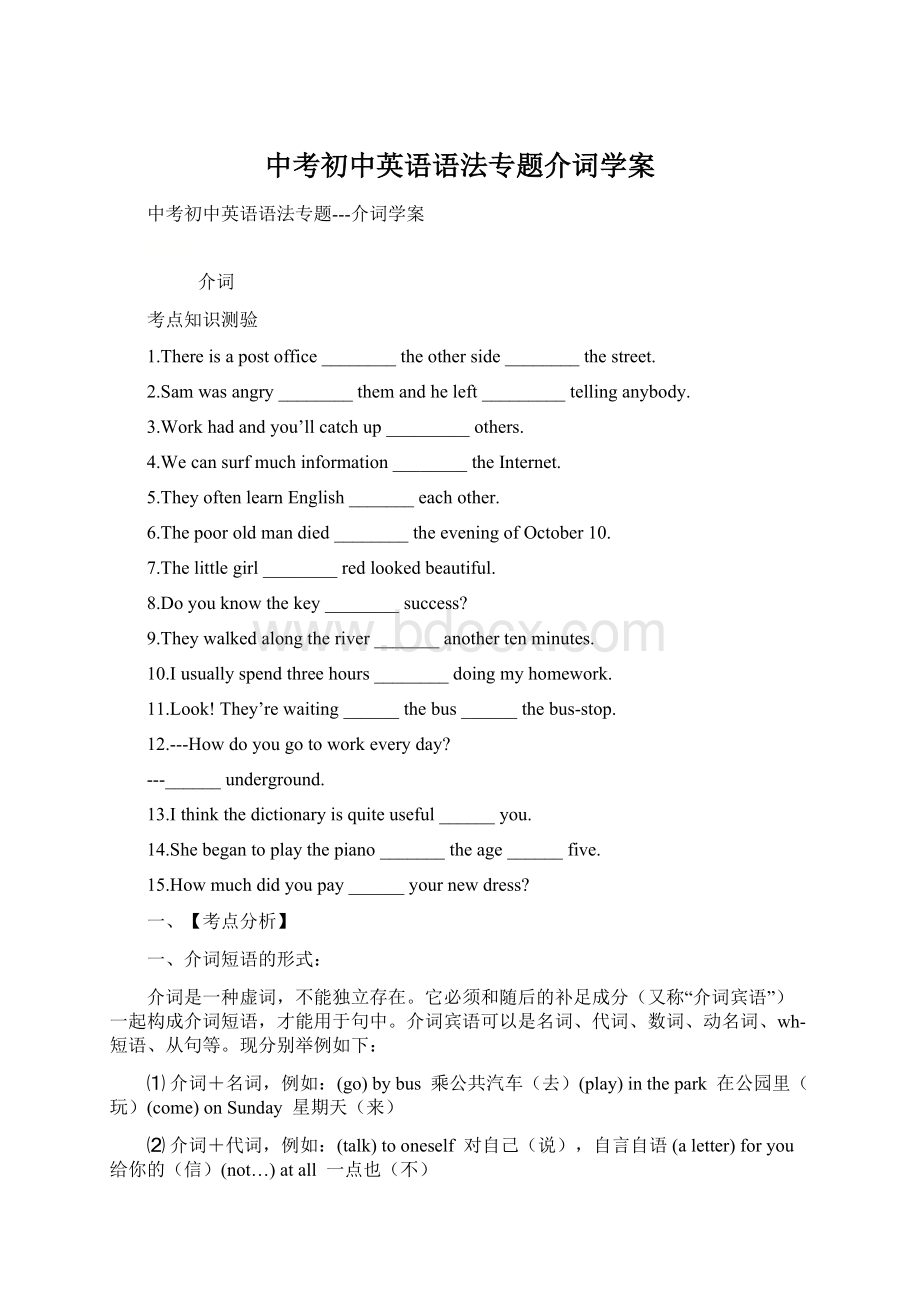中考初中英语语法专题介词学案.docx
《中考初中英语语法专题介词学案.docx》由会员分享,可在线阅读,更多相关《中考初中英语语法专题介词学案.docx(25页珍藏版)》请在冰豆网上搜索。

中考初中英语语法专题介词学案
中考初中英语语法专题---介词学案
介词
考点知识测验
1.Thereisapostoffice________theotherside________thestreet.
2.Samwasangry________themandheleft_________tellinganybody.
3.Workhadandyou’llcatchup_________others.
4.Wecansurfmuchinformation________theInternet.
5.TheyoftenlearnEnglish_______eachother.
6.Thepooroldmandied________theeveningofOctober10.
7.Thelittlegirl________redlookedbeautiful.
8.Doyouknowthekey________success?
9.Theywalkedalongtheriver_______anothertenminutes.
10.Iusuallyspendthreehours________doingmyhomework.
11.Look!
They’rewaiting______thebus______thebus-stop.
12.---Howdoyougotoworkeveryday?
---______underground.
13.Ithinkthedictionaryisquiteuseful______you.
14.Shebegantoplaythepiano_______theage______five.
15.Howmuchdidyoupay______yournewdress?
一、【考点分析】
一、介词短语的形式:
介词是一种虚词,不能独立存在。
它必须和随后的补足成分(又称“介词宾语”)一起构成介词短语,才能用于句中。
介词宾语可以是名词、代词、数词、动名词、wh-短语、从句等。
现分别举例如下:
⑴介词+名词,例如:
(go)bybus 乘公共汽车(去)(play)inthepark 在公园里(玩)(come)onSunday 星期天(来)
⑵介词+代词,例如:
(talk)tooneself 对自己(说),自言自语(aletter)foryou 给你的(信)(not…)atall 一点也(不)
⑶介词+数词,例如:
(cutsth)intwo (把……切)成两半
⑷介词+动名词,例如:
(away)ofdoingthat 做那件事的(方式)begoodatdrawingpictures善于画画
⑸介词+wh-短语,例如:
(talk)aboutwhattodonext(谈论)下一步该做什么
⑹介词+从句,例如:
PleasethinkofwhatIsaid. 请你考虑我说的话。
二、介词短语的基本用法:
⑴介词短语用作表语,例如:
Thepostofficeisjustacrossthestreet.
Shelookssomuchlikehermother.
⑵介词短语用作宾语补足语,例如:
Iwassurprisedtofindhimonthebus.
Pleasemakeyourselfathome.
⑶介词短语用作后置定语,例如:
Thegirlinthehatismysister.
Doyoulikethejacketontheleft?
Didyouseethehousewithmanytreesaroundit?
⑷介词短语用作状语,例如:
WhatareyougoingtodoonChristmas?
Apolicemanisstandingnexttohim.
Bytheway,whattimeisitnow?
MissZhaocameinwithabigsmileonherface.
二、常考点清单
一、初中英语常用介词短语
1.atonce立刻2.atlast最后
3.atfirst起先,首先4.attheageof...在……岁时
5.attheendof...在……之末6.atthebeginningof..在……之初
7.atthefootof...在……脚下8.atthesametime同时
9.atnight/noon在夜里/中午
10.withone'shelp在某人的帮助下,由于某人的帮助
11.withthehelpof...在……的帮助下12.withasmile面带笑容
13.withone'sowneyes亲眼看见14.afterawhile过了一会儿
15.fromnowon从现在起16.fromthenon从那时起
17.forexample例如18.farawayfrom远离
19.frommorningtillnight从早到晚20.byandby不久
21.byairmail寄航空邮件
22.bybike/air/train/bus骑自行车/乘飞机/火车/公共汽车
23.byordinarymail寄平信24.bytheway顺便说
25.bythewindow在窗边26.bytheendof...到……底为止
27.littlebylittle逐渐地28.inall总共
29.infact事实上30.inone'stwenties在某人二十几岁时
31.inahurry匆忙32.inthemiddleof在……中间
33.innotime(inaminute)立刻,很快34.intime(ontime)及时
35.inpublic公众,公开地36.inorderto为了….
37.in(the)frontof在……前面38.inthesun在阳光下
39.intheend最后,终于40.insurprise惊奇地
41.inturn依次42.ofcourse当然
43.abit(of)有一点儿44.alotof许多
45.alittle-点儿46.onone'swayto某人在去……的路上
47.onfoot步行,走路48.atalkonspace关于太空的报告
49.ontheotherhand另一方面50.at/ontheweekend在周末
51.ontheleft(right)在左(右)边52.ontheothersideof在……另一边
53.ontheradio通过收音机(无线电广播)54.toone'sjoy使……高兴的是
55.toone'ssurprise使……惊讶的是
二、常用介词的基本用法
基本
分类
基本用法
例子
时
间
介
词
at多用于表示具体的钟点时刻前,也可用于固定搭配中,表示的时间大多比较短暂。
atseven
ataquartertoone
atnoon
atnight
in表示一段时间,如:
年、月、世纪、四季或泛指一天的上午、下午、晚上等。
还可用于表示“从现在起,多长时间以后或多久以后”的短语。
inthetwenty-firstcentury
inautumn
inthemorning
Theywillfinishtheworkinanhour.
on主要用于表示星期几,具体某一天的早、午、晚或用在时间名词有形容词修饰前。
onMid-autumnDay
onJunelst
onasunnymorning
since指从某时一直延续至今,后接时间点/时间段+ago/从句,主句用完成时。
HehasstudiedEnglishsince2000.
HehasbeeninGuangzhousincetwoyearsago.
from.说明开始的时间,谓语可用过去、现在、将来的某种时态。
Fromnowon,IwilllearnEnglishinthemornings.
for指动作延续贯穿整个过程,后接时间段
IhavestudiedEnglishforsixyears.
after:
(1)过去为起点的某一段时间之后,用于过去时。
(2)与时间点连用表示在将来某个时间之后。
Theyfinishedtheworkaftertwoyears.
I’llringyouupaftertwoo'clock.
until用于否定句中,意为“直到……才”,其前的谓语动词多用瞬间性动词;用在肯定句中,意为“直到……为止”,其前的谓语动词须用延续性动词。
Ididn'tgotobeduntilmymothercamehome.
Iwaitedformymotheruntilshecamehome.
“by+时间点”表示“到……为止”,如果by后加“将来的时间点”应用一般将来时;如果by后跟一个过去的时间点应用过去完成时。
Wehadlearnedl,000Englishwordsbytheendoflastterm.
“during+时间段”与延续性动词连用表示某期间的动作。
Heliveswithusduringtheseyears.
before表示时间,意为“在……之前”。
Pleasebringyourhomeworkbeforeteno'clock.
地
点
介
词
at表示较小的地点。
(如车站,村庄等)
atthebusstop;
athome;
at249XiajiuRoad
in表示较大的地方。
(国家、城市等)
用在地点名词前不用介词
inChina;
intheworld
如:
arrivehome/here/there
on表示“在……上面”,强调表面接触。
Lookatthebookonthedesk.
over指“在……正上方”,表垂直在上。
Thereisabridgeovertheriver.
above指“在上方”,属于斜上方。
Raiseyouranusaboveyourhead.
below表示“在下方或位置低于……”,不一定有垂直在下之意。
Thecoatreachesbelowthe